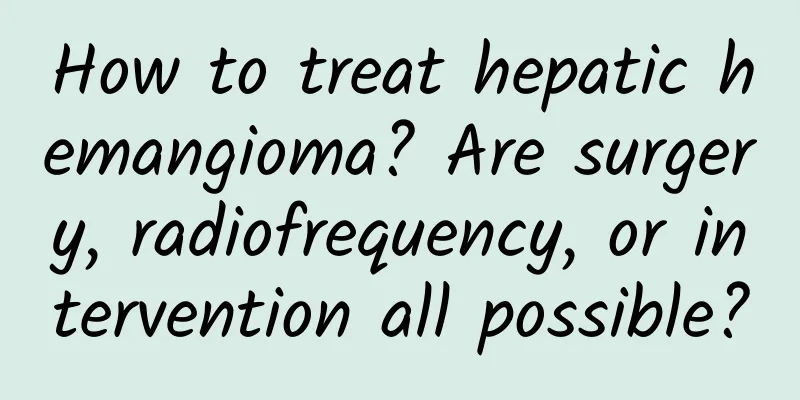How to treat hepatic hemangioma? Are surgery, radiofrequency, or intervention all possible?

|
Author: Yang Zhiying, Chief Physician of China-Japan Friendship Hospital Reviewer: Shi Wenzai, attending physician at Peking University International Hospital Drugs are an important weapon in treating diseases, but so far, there is no drug that is clearly effective for hepatic hemangioma. Therefore, if you see on the Internet that someone can use drugs to treat hemangiomas, this information is usually unreliable. So do all hepatic hemangiomas need to be treated? How can they be cured? Can radiofrequency therapy be used? Can interventional therapy be used? Let's take a look. 1. Do all hepatic hemangiomas need to be treated? More than 95% of hemangiomas are smaller than five centimeters. They have no effect on the human body and no obvious symptoms. Such hemangiomas only need to be observed regularly and do not require any treatment. Of course, whether hepatic hemangioma needs treatment is not only determined by its size, but also by its symptoms, growth location, and growth pattern. Figure 1 Original copyright image, no permission to reprint For example, a hemangioma of about six or seven centimeters in size on the right liver grows inside the liver. It has no effect on the human body and does not require treatment. Just observation is enough. However, if this six or seven centimeter hemangioma grows in the left liver, it may have pressed on the stomach and caused obvious symptoms, such as a noticeable feeling of fullness after meals, and active treatment is required. So it does not mean that hepatic hemangioma larger than five centimeters must be treated, but there must be a clear indication for treatment. What specific indication is it? First, there are symptoms, such as exogenous hemangioma compressing the stomach and causing a feeling of fullness, which is very uncomfortable. Second, it grows very fast, perhaps more than one or two centimeters a year. Third, hemangiomas in the left liver must be larger than eight centimeters, and hemangiomas in the right liver must be larger than ten centimeters before treatment is considered. If the hemangioma is seven or eight centimeters in size, has no symptoms, is located inside the liver, and grows very slowly, we recommend that you continue to observe it and do not touch it at will. 2. How to cure hepatic hemangioma? The cure for hepatic hemangioma is resection, which can be divided into two types: One is a hemangioma connected to the liver. The hemangioma and nearby liver tissue are removed together. This is the traditional method, which is relatively clear and the entire thing is removed, but the problem is that such a large piece of good liver is lost. Of course, some people say that it is no problem for a normal person to cut off half of the liver, or 70% of the liver, and it will have little effect on the human body. However, it is better for the human body if this part of liver tissue with normal function can be retained. There is another method now, which is to remove the hemangioma from the liver like digging a potato. It only removes the tumor without affecting the surrounding liver tissue. This is called stripping. Most hemangiomas can be treated with stripping. Of course, some are particularly huge. For example, there was a male patient whose hepatic hemangioma grew to more than 50 centimeters in size. His belly was as big as that of a pregnant woman, and the entire right liver was covered with large hemangiomas. This type of hemangioma could not be removed, so we had to remove the right liver together. 3. Can hepatic hemangioma be treated with radiofrequency? What is radiofrequency therapy? It is to take a needle and insert it into the hemangioma, and then the needle tip can be heated, which is equivalent to burning the hemangioma to death. This method has certain limitations and has not become the mainstream treatment for liver hemangioma. Why? Because this radiofrequency treatment can usually achieve very good results for hemangiomas smaller than five centimeters, but the problem is that according to the guidelines, hemangiomas smaller than five centimeters usually do not require treatment. If a hepatic hemangioma is larger than five centimeters, it has two problems: First, radiofrequency burns the entire hemangioma, which is difficult because the hemangioma is so large; Second, because hemangioma is a blood reservoir with a large amount of blood, when it is burned using radio frequency heating methods, a large number of red blood cells will be destroyed. We know that after a large number of red blood cells are destroyed, hemoglobin is released, which will cause hyperhemoglobinemia, which can easily cause acute renal failure and have serious consequences, so the gain will not outweigh the loss. At the same time, such a large hemangioma is prone to complications such as abscess, infection, necrosis, etc. after radiofrequency treatment. Therefore, if a liver hemangioma larger than five centimeters is treated with radiofrequency, firstly, the treatment effect is unreliable, and secondly, the possibility of various accidents is relatively high. Therefore, radiofrequency has its limitations and we do not recommend it. Figure 2 Original copyright image, no permission to reprint 4. Can hepatic hemangioma be treated interventionally? What is interventional therapy? Hemangiomas have many blood vessels, and blood keeps flowing into them, filling the hemangiomas with blood. Interventional therapy is to block some of the blood vessels that enter the hemangiomas through the arteries, so that blood cannot enter the hemangiomas, and the hemangiomas become smaller. This is called interventional embolization therapy. But this approach has several problems: First, because there are many collateral blood vessels around hepatic hemangioma, it is impossible to block all of them, so its effectiveness is not particularly high. Statistics show that the effectiveness is only about 50%; Second, the recurrence rate is relatively high. After five or six years, or six or seven years, the tumor will grow back again. Third, there are several major problems with interventional embolization that may be encountered in clinical practice. 1. Necrosis. After necrosis, liver abscess is formed, which is very serious. Second, embolization may cause bile duct necrosis, bile duct occlusion or rupture, and cholesteatoma, which is also a serious complication after embolization. Third, one of the commonly used embolic agents is called bleomycin, which may cause pulmonary fibrosis, which is also a shortcoming of interventional embolization. Therefore, interventional embolization is only used in the following cases: First, some hemangiomas are too large. As a treatment method before surgery, the huge hemangiomas will be relatively smaller after interventional embolization, and the surgery will become relatively easier. Second, if the hemangioma is too large to be operated on, or the hemangioma is in a particularly important part and the risk of surgery is too high, interventional embolization may make the hemangioma smaller and relieve symptoms. In other words, patients who are not suitable for surgery can try it. This is our principle. |
<<: How is gallbladder cancer treated? Are radiotherapy and chemotherapy effective?
Recommend
Can I prepare for pregnancy if I have bacterial vaginitis?
Compared with men, women's bodies are very fr...
Is it normal to delay your period by five or six days?
Women have their periods every month, which is a ...
Pelvic inflammatory bleeding pictures
Some patients with pelvic inflammatory disease of...
Leucorrhea has been yellow since childhood
When women are still in their teenage years, they...
A picture of a woman's vaginal discharge
Nowadays, the influence of women in daily life co...
Can chamomile essential oil treat abnormal leucorrhea?
Chamomile essential oil has a relatively high med...
Generally speaking, it is better to do four-dimensional color Doppler ultrasound in a few months of pregnancy
A sailing ship, a fully armed man and a pregnant ...
How can women adjust their internal and external
How do women generally regulate their internal an...
Can pregnant women use laundry detergent?
The production of laundry detergent requires a la...
Episerver: Reimagining eCommerce for 2020
Episerver has released a new report, "Reimag...
Please remember these four lines of defense to prevent myocardial infarction! Compare and see how many of them you have achieved?
Not long ago, a young man suddenly suffered chest...
Why is my period delayed for five days and still not coming?
Some female patients have health problems, especi...
When is the pregnancy test effective?
Many friends do not understand the best time to u...
What to do if there is a foreign object in the vagina
For friends who have foreign objects in the vagin...
Where can I take photos of pregnant women?
Many pregnant women may want to take some materni...









